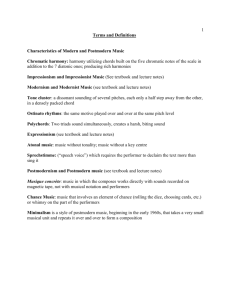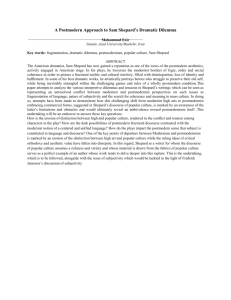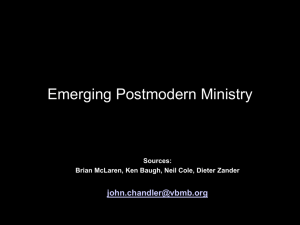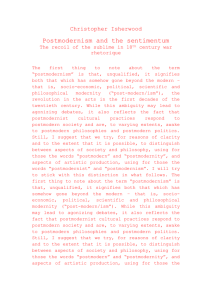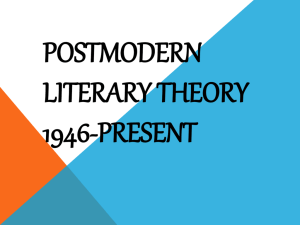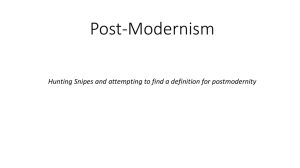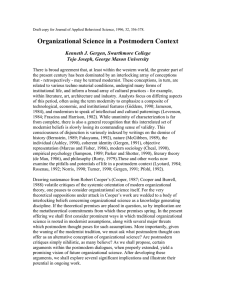The Blind Assasin
advertisement
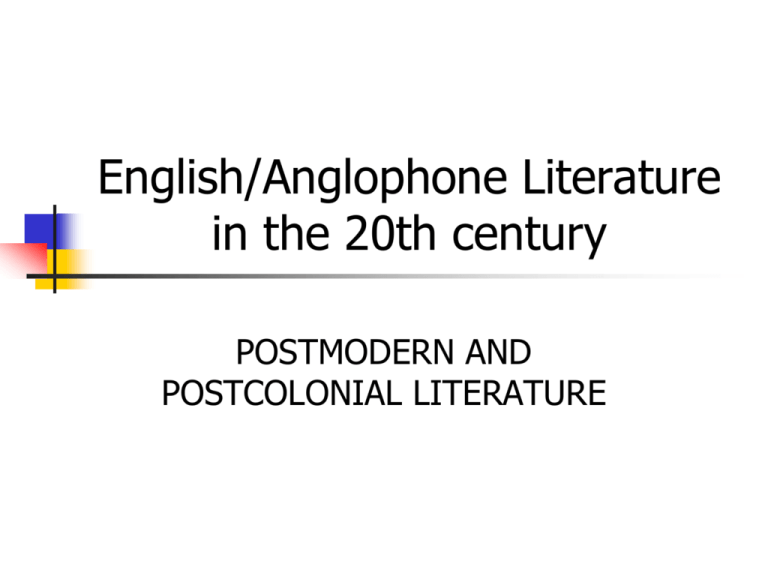
English/Anglophone Literature in the 20th century POSTMODERN AND POSTCOLONIAL LITERATURE Postmodern Literature The term Postmodern literature is used to describe certain tendencies in post-World War II literature. It is both a continuation of the experimentation of modernist writers (fragmentation, paradox, questionable narrators, etc.) and a reaction against Enlightenment ideas implicit in Modernist literature. Postmodern literature, like postmodernism as a whole, is difficult to define and there is little agreement on the exact characteristics, scope, and importance of postmodern literature. Background Influenced by authors and works who experimented with form, narrative and chronology; who employed parody, chance, playfulness, dreams Sterne’s Tristram Shandy, Byron’s Don Juan, Oscar Wilde, Lewis Caroll Comparisons with Modernism Both modern and postmodern literature - a break from 19th century realism. Character development: both modern and postmodern literature explore subjectivism, turning from external reality to examine inner states of consciousness, in many cases drawing on modernist examples in the stream of consciousness styles of Virginia Woolf and James Joyce, or explorative poems like The Waste Land by T. S. Eliot. Both modern and postmodern literature explore fragmentariness in narrative- and character-construction. Modernist literature sees fragmentation and extreme subjectivity as an existential crisis, or Freudian internal conflict, a problem that must be solved, and the artist is often cited as the one to solve it. Postmodernists, however, often demonstrate that this chaos is insurmountable; the artist is impotent, and the only solution against "ruin" is to play within the chaos. Playfulness is present in many modernist works (Joyce's Finnegans Wake or Virginia Woolf's Orlando, for example) and they may seem very similar to postmodern works, but with postmodernism playfulness becomes central – order and meaning cannot be achieved. Post? After Modernism? Against Modernism? A new era? Or all three? Postmodern literature, like postmodernism as a whole, is hard to define. Hardly any agreement on the exact characteristics, scope, and importance of postmodern literature. For example, instead of the modernist quest for meaning in a chaotic world, the postmodern author abandons, often playfully, the possibility of meaning, and the postmodern novel is often a parody of this quest. Common Themes and Techniques Irony, playfulness, black humour (treating serious subjects in a humorous way – Joseph Heller, Catch 22 – World War II) Intertextuality (reference or parallels to another literary work, often of a different genre – fairy tales, myth, crime fiction, SF – Umberto Eco, The Name of the Rose, Margaret Atwood, The Blind Assasin) Pastiche (similar to intertextuality, pasting together multiple elements – SF, detective fiction, fairy tales) Metafiction or self-reference (writing about writing, author –character in John Fowles’ The French Lieutenant’s Woman) Historiographic metafiction (fictionalizing actual historical events or figures – Kazuo Ishiguro, The Remains of the Day – WW II and the events leading to it seen through the narrator’s eyes) Temporal distortion (Non-linear narratives, fragmentation, frame narrative, multiple endings – present in many PoMo novels) Questionable narrators (instead of the omniscient author, narrators are characters themselves who often deceive the reader – The Remains of the Day, The Blind Assasin, American Psycho) Technoculture and hyperreality (information age - society has moved past the industrial age.Baudrillard -postmodernity defined by a shift into hyperreality in which simulations have replaced the real. Technology has become a central focus in many lives, and our understanding of the real is mediated by simulations of the real. Don DeLillo's White Noise - characters are bombarded with a "white noise" of television, product brand names, and clichés.) British PoMo Authors Salman Rushdie, The Satanic Verses Julian Barnes, Flaubert’s Parrot Ian McEwan, Atonement Peter Ackroyd, Hawksmoor Martin Amis, Time’s Arrow Angela Carter, Wise Children Kazuo Ishiguro, The Remains of the Day John Fowles, The French Lieutenant’s Woman Sarah Waters, The Little Stranger American PoMo Authors Vladimir Nabokov, Pale Fire Thomas Pynchon, Gravity’s Rainbow Kurt Vonnegut, Slaughterhouse Five Cormac McCarthy, Blood Meridian Toni Morrison, Beloved Paul Auster, The New York Trilogy Don DeLillo, White Noise Introduction to Australian Literature Australian literature literary work produced in the area or by the people of the Commonwealth of Australia and its preceding colonies. Australia was a collection of British colonies, therefore, its literary tradition begins with and is linked to the broader tradition of English literature. Since 1788, the character of a new continent is introduced into literature - exploring such themes as Aboriginality, mateship, egalitarianism, democracy, migrant and national identity, distance from other Western nations and proximity to Asia, the complexities of urban living and the "beauty and the terror" of life in the Australian bush First landing by Dutch explorers, beginning of 17th century First settled at the end of the 18th century, as a penal colony of Great Britain. First literary works by British explorers and officers – accounts of the settlement of Australia. As a British colony and later a Commonwealth state, Australia profoundly influenced by Britain in all aspects of society AustLit – since 19th century First popular works – novels about life on the frontier, using vernacular language (Australian dialect) Later in the 19th century – Gothic novels, poetry, drama, children’s literature, histories Themes in AustLit Relationship to Australia – country often seen as threatening and alien Mateship - intensly loyal relationship of shared experience, mutual respect and unconditional assistance existing between friends (mates) in Australia National identity – what it means to be Australian – Patrick White and Peter Carey Since mid-20th century, AustLit emerges with a distinctive voice of its own Not least under the influence of extensive immigration from Asia and Europe Immigrants brought in elements of their culture and identity to Australian literature Significant and Contemporary Australian Authors Patrick White (Nobel Prize 1973), Riders in the Chariot Elizabeth Jolley, Milk and Honey, Lovesong Peter Carey (Man Booker Prize 1988, 2001), Oscar and Lucinda, True History of the Kelly Gang Thomas Keneally, Schindler’s Ark Colleen McCullough, The Thorn Birds Introduction to Canadian Literature Canada's dominant cultures were originally British and French, as well as aboriginal. Since the 1970s, Canada gradually became home to a more diverse population of readers and writers. The country's literature has been strongly influenced by international immigration, particularly in recent decades. Similar to Australia, as a British colony and later a Commonwealth state, Canada was profoundly influenced by Britain in all aspects of society. Canada officially became a country only in 1867, it has been argued that literature written before this time was colonial. Literatures of Australia and Canada are often labelled ‘postcolonial’. First Authors Susanna Moodie and Catherine Parr Traill, English sisters who adopted the country as their own, moved to Canada in 1832. They recorded their experiences as pioneers. Moodie's Roughing It in the Bush (1852) and Life in the Clearings (1853). Their books often dealt with survival and the rugged Canadian environment. Characteristics of CanLit Canada’s literature, whether written in English or French, often reflects the Canadian perspective on: (1) nature, (2) frontier life, and (3) Canada’s position in the world. Canada's ethnic and cultural diversity are reflected in its literature, with many of its most prominent writers focusing on ethnic life. Important Themes of CanLit Failure and futility of human efforts (human vs. nature – since colonial times) Mild anti-Americanism (rivarly between two nations) Multiculturalism National identity (often against the US) Nature (human vs. nature) – nature portrayed both as an enemy, and a divine force Search for self-identity – need to find one’s identity and justify one’s existance Since 1970s, CanLit emerges with a voice of its own. During the post-war decades only a handful of books of any literary merit were published each year in Canada, and Canadian literature was viewed as an appendage to British and American writing. The best-known living Canadian writer internationally is Margaret Atwood, a prolific novelist, poet, and literary critic. Atwood and Alice Munro, who has been called the best living writer of short stories in English, were the first to elevate Canadian Literature to the world stage. Significant Canadian Authors Michael Ondaatje (Man Booker Prize, 1992), The English Patient Margaret Atwood (Man Booker Prize, 2000), The Blind Assasin Yann Martel (Man Booker Prize, 2002), Life of Pi Leonard Cohen – poet, singer and songwriter Alice Munro, short-story writer
